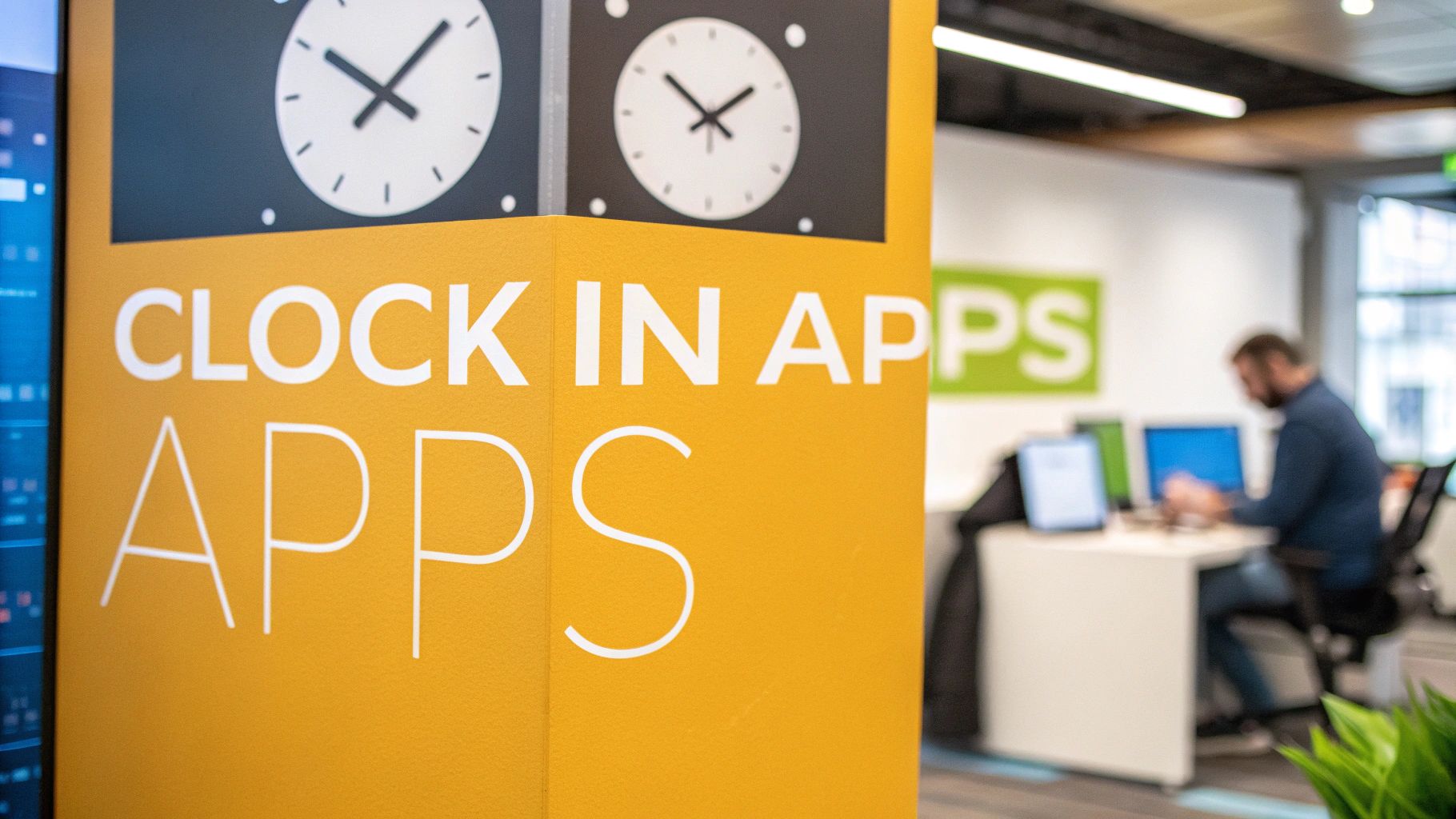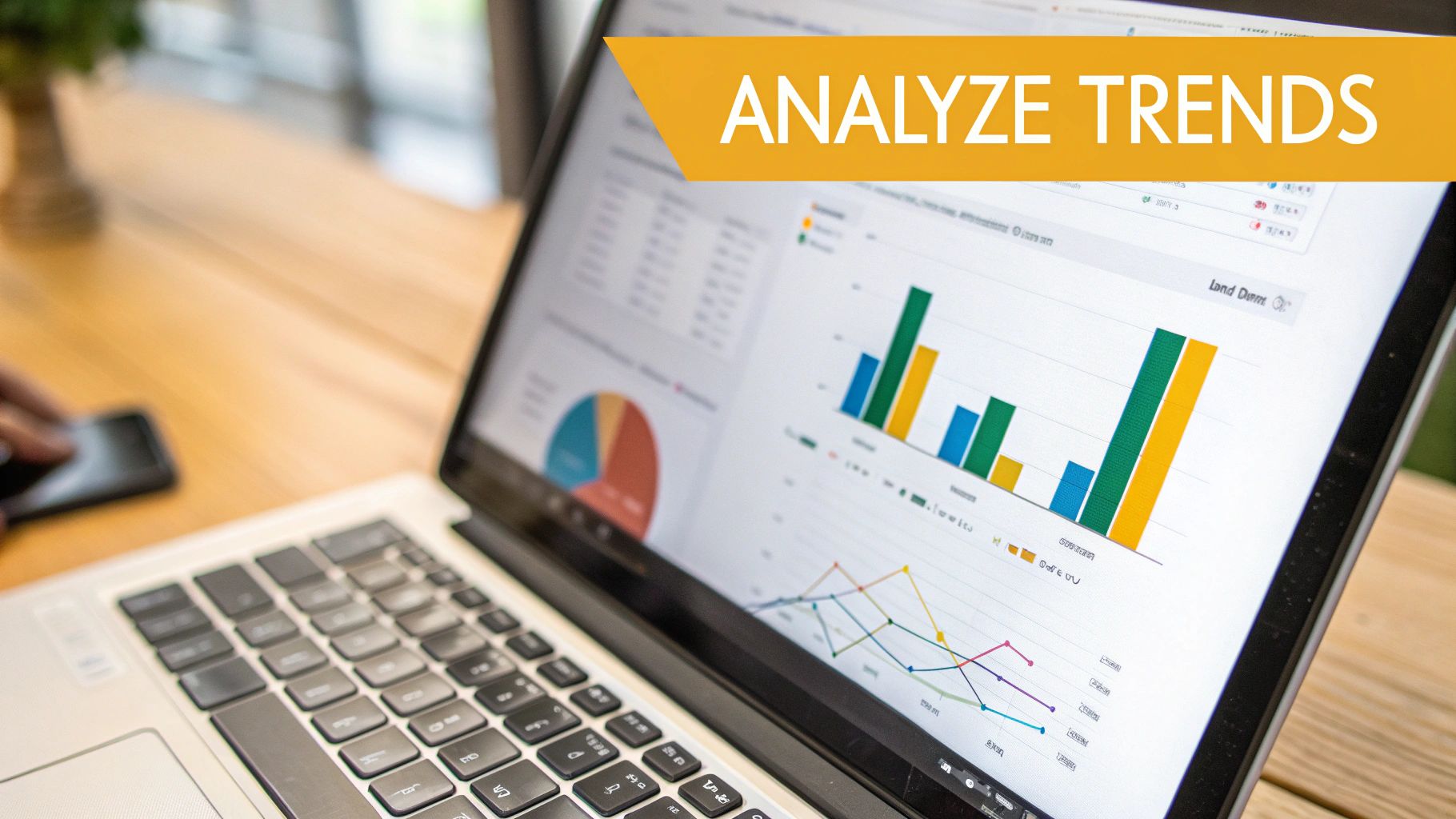From our resource library for organizational scheduling and management.
The Ultimate Guide to Apps for Clocking In: Transform Your Business Time Management

The Digital Revolution in Time Management
Time tracking at work has come a long way. The old days of paper timesheets and punch cards are giving way to modern digital clocking apps. These tools are making it much easier for companies to track work hours while giving employees more control over their time records.
From Paper to Digital: Making Time Tracking Better
The old paper-based systems had lots of problems. Time cards could get damaged or misplaced, and sometimes people would fudge their hours. This created headaches for payroll and HR teams. But digital time tracking apps have fixed many of these issues. They're more accurate, don't need manual data entry, and help prevent mistakes. This means less time spent on administrative tasks. Learn more: How to master management software services and transform your business operations.
Mobile Apps and Real-Time Updates
With everyone carrying smartphones these days, digital time tracking has really taken off. These apps let workers clock in from anywhere, which is perfect for remote teams and people who travel for work. Managers can see work hours in real-time, making it easier to plan schedules and track productivity.
The numbers show how popular these tools have become. The time tracking software market was worth $6.08 billion in 2023, dipped to $5.75 billion in 2024, but is expected to reach $25.48 billion by 2032. That's a growth rate of 17.26% each year from 2023 to 2032. Check out the full report here: Time Tracking Software Market Research
Better Visibility for Everyone
These apps aren't just good for employers - they help workers too. Employees can easily check their hours, track breaks, and make sure they're paid correctly. This openness builds trust between companies and their workers, leading to happier, more productive teams. It's no wonder more businesses are switching to these user-friendly tools.
Unlocking Hidden Profits Through Modern Time Tracking

Smart time tracking using clock-in apps offers real financial benefits for businesses. When you understand exactly where time and money flow in your organization, you can spot opportunities to work more efficiently. Many companies lose money through poor time tracking, which directly impacts their bottom line. It's time to move past basic hour logging to systems that show you meaningful patterns and trends.
The High Cost of Inaccurate Timekeeping
Paper timesheets and basic spreadsheets often lead to costly mistakes. These can be simple typos or employees rounding up their hours. The administrative burden is also significant - think about how many hours your team spends collecting and reviewing paper timesheets each week. That's valuable time they could spend on work that grows your business.
Old-school time tracking also makes it hard to monitor project progress and assign the right people to tasks. Projects run over budget, deadlines slip, and money gets left on the table. Modern clock-in apps help solve these problems.
How Time Tracking Apps Drive Profitability
Good time tracking does more than just record hours worked. Here's how these tools can boost your finances:
- Better Payroll: Automatic calculations mean fewer mistakes and happy employees who get paid the right amount
- Smarter Project Planning: See exactly where time goes so you can create accurate budgets and catch issues early
- Right People, Right Place: Data shows which teams are overworked or underused so you can balance workloads
- More Billable Time: Track client work precisely to ensure you capture and bill for all your team's efforts
The numbers tell the story: Poor time management costs U.S. businesses over 50 million hours of productivity - that's $7.4 billion lost every day. Making one simple change from weekly to daily timesheet updates could save $52,000 per employee per year in billable hours. Learn more here: How Much Money Does a Time Tracking App Save You?
Making the Switch to Modern Time Tracking
Moving to a new time tracking system might feel like a big step, but the rewards are worth it. Many apps connect smoothly with your existing payroll and accounting tools. Plus, they're built to be simple and straightforward - your team can learn them quickly. Taking this step helps you find hidden ways to save money and sets up your business for steady growth.
Key Features of Modern Employee Time Tracking

Today's time tracking apps offer much more than just recording when employees start and end their shifts. The right app can help businesses run more smoothly and save money by providing advanced tools for managing staff time and attendance.
GPS Tracking and Geofencing
Modern apps use GPS tracking to check where employees are when they clock in and out. This helps stop "buddy punching" - when workers try to clock in for each other. Many apps also include geofencing, which creates virtual boundaries around work locations. Workers can only clock in when they're physically inside these zones, making time tracking more accurate for teams working in the field.
Biometric Verification
Some apps add extra security through biometric verification using fingerprints or facial recognition. This makes sure the right person is clocking in and creates more reliable time records. It's especially useful in industries that need strict security measures.
Real-Time Reporting and Analytics
Managers can now see workforce data as it happens. They can quickly spot scheduling issues, check project progress, and see who's working right now. The analytics tools help spot patterns in how time is used and show ways to improve scheduling and productivity. This helps companies make better decisions based on real data.
Seamless Integrations
Modern time tracking connects with other business tools to create smooth workflows. For example, TeamBridge combines time tracking with scheduling, onboarding, payroll and more in one system. These apps work together with payroll systems and project tools, removing the need to enter data multiple times and reducing mistakes. You might also find helpful: How to Transform Your Workforce Management with Shift Scheduling Apps.
Picking an app with the right mix of these features can help your business run better, track time more accurately, and get more done with less effort.
Mastering the Implementation Process
Getting your team to adopt new time clock apps requires careful planning and execution. With the right approach, you can make this transition smooth and successful. Let's explore proven strategies to help your team embrace the new system and get the most from modern time tracking tools.
Planning Your Rollout: A Step-by-Step Guide
Starting with a clear plan helps everyone understand what to expect. Here's what you need to focus on:
Review Current System: Take stock of how your team tracks time now. What works? What causes headaches? Understanding these points helps pick the right solution.
Pick the Right Tool: Choose an app that fits your needs and works with your existing tools. Test it with a small group first using a free trial - this helps spot potential issues early.
Handle Old Records: Plan how you'll move existing time data to the new system. Good record-keeping during the switch prevents payroll issues later.
Keep Everyone Updated: Share why you're making the change, how it helps the team, and when things will happen. Clear communication builds trust and reduces worry.
Training Your Team for Success
Good training makes all the difference in how quickly people adapt. Here's how to help your team learn effectively:
Practice Sessions: Run small group sessions where people can try out the app themselves. Work through real examples they'll face day-to-day.
Quick Reference Guides: Create simple how-to guides and short videos people can check when they need help. Keep these easy to find and use.
Support Team: Have a few team members become experts who can help others. Make sure everyone knows who to ask for help when they get stuck.
Overcoming Resistance and Building Buy-In
Change can make people nervous. Here's how to help your team feel good about the new system:
Listen to Worries: Make time to hear what concerns people have. Show them how the new system makes their work easier, like quick timesheet checks and simple time-off requests.
Show Real Benefits: Focus on what's in it for them - faster payroll, easier schedule checking, and less paperwork hassle.
Ask for Input: Check in regularly to see how things are going. When people point out problems, fix them quickly. This shows you value their experience.
Following these steps helps make your new time tracking system work better for everyone. When people see how it makes their work easier, they're more likely to use it properly and help others do the same.
Compliance and Security in Time Tracking

Good time tracking apps must prioritize security and follow all relevant regulations. Choosing the right solution means carefully evaluating how it handles sensitive employee data and builds trust with your team.
Key Legal Requirements to Consider
Labor laws differ between states and countries, so your time tracking needs to match local rules. For instance, some places require specific break tracking and overtime calculations. You'll want an app that handles these requirements correctly. Data privacy regulations like GDPR also affect employee data collection and storage - make sure any solution you pick follows these rules.
Critical Security Features
Employee data protection requires strong safeguards. Look for time tracking apps with essential security features like encrypted data storage, regular security patches, and multi-factor authentication. Access controls that limit who can view sensitive information add another important layer of protection.
Creating Trust Through Clear Communication
When rolling out a new time tracking system, explain everything to your team upfront. Tell them what information gets collected and how you keep it secure. This openness helps everyone feel more comfortable using the system. You might find this helpful: How to Master Employee Scheduling with Modern Workforce Management Tools. Written policies that spell out time tracking procedures also help set clear expectations.
Security and Compliance Checklist
Here are the key steps to follow:
- Know Your Rules: Stay current on local labor and privacy laws
- Pick Compliant Tools: Choose apps built to meet specific legal needs
- Lock Down Data: Use strong security features to protect employee information
- Be Open: Share how data gets collected and protected
- Document Everything: Create clear written policies about time tracking
- Stay Current: Review and update your approach as laws change
Taking these steps protects both your business and employees. It creates a foundation of trust that helps everyone work better together.
The Future of Workplace Time Management

Time tracking at work is changing fast as new technology emerges. Modern apps for tracking work hours are just the beginning - fresh developments are reshaping how businesses monitor and optimize their time. Companies that adapt early gain an edge over competitors.
AI and Machine Learning: Predicting and Optimizing
Artificial intelligence is making time tracking smarter, not just more accurate. AI analyzes past data to better predict how long projects will take and what resources they'll need. This helps managers adjust schedules before problems arise. Machine learning also spots patterns in how employees work, showing where teams could be more productive.
Advanced Analytics: Unlocking Deeper Insights
Modern time tracking reveals more than just when people work - it shows how they spend their hours. Advanced data analysis connects time use to real results like project success, billing accuracy, and employee satisfaction. This gives companies clear evidence of what makes their teams efficient and profitable. These insights help leaders make better choices about staffing and workflows.
Integrations and the Connected Workplace
Time tracking systems now work smoothly with other workplace tools. When your clock-in app talks directly to project management software and payroll systems, everything runs more smoothly. This cuts down on manual data entry and mistakes. For instance, tracked hours can automatically update project status reports and create accurate invoices.
Preparing for the Future of Time Tracking
Smart companies are already testing these new tools. They're trying out AI scheduling assistants, setting up analytics dashboards, and picking time tracking apps that work well with their other software. But success isn't just about new tech - it's about building a workplace culture that uses data wisely. Companies win when employees understand how to use time tracking information to work better, both individually and as teams.
Want to improve how your company manages time? Acroroster offers powerful scheduling tools built for modern businesses. From creating work schedules to managing shift changes and tracking who's available, Acroroster has everything you need. Visit their website to start your free trial and see the difference for yourself.